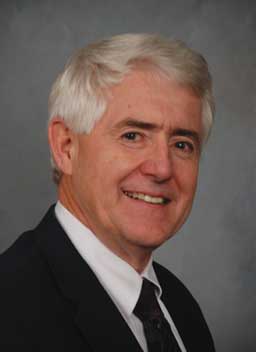President’s message
The 40th afterglow
Returning from the 40th annual meeting provided a little time for some retrospective contemplation – a meeting post mortem of sorts, mentally reviewing session by session, speaker by speaker. Productivity in airports and in the air is typically lacking, especially when traveling with an entourage, thus this is a good time to get lost in thoughts of recent events and plan for the future. There was no lack of reflections over the meeting successes and of course over the many congratulatory edicts offered by good friends and colleagues. There seemed to be an aura of optimism surrounding this year’s meeting in spite of the difficult economic times and considering the ever-challenging environment in which we work. One thing is for sure: the AASV is alive and well. Professionalism has never been at a higher mark and the future looks bright, with so many energetic and high-quality students interested in swine-production business and medicine. One of the ways we will certainly “Assure our AASV future” will be through the next generation of bright, highly qualified swine veterinarians. Attending the student sessions provided ample opportunity to glimpse that time-to-come. We can be confident in this. My hat is off to the student-recruitment committee. Spirits were high on this trip home. You might say an afterglow surrounded the plane all the way back to Ames.
It seems the program committee hit a home run this year – they are to be congratulated and given credit for their good work. There was also an element of fortuitous luck with a great venue choice. Combined with the program, a record crowd attended. The great weather and good flight connections were another plus that together helped the stars align. I hope the executive board keeps this information in mind as we choose future destinations. All the comments coming from friends were positive. Some raved on and on, but as always there were a few suggestions and somewhat timidly offered circumscriptions. There are those in our membership who have the gift of carefully and skillfully evaluating every moment of life. Nothing slips past their earnest gaze. They are especially adept at spotting all things out of balance in the barns and are champions for their customers. They could be named, but you already know them. They are especially courteous and nonjudgmental while driving home their points of concern. Yes, there were a few “perhaps you should have” comments….. good friends can be brutally honest. Reflecting on these sincerely provided “reservations” eventually sent me plummeting back to earth, back to the reality of the present and the significant issues which the future holds for our customers and a livestock-naive society.
When the program committee planned this event way back in June of 2008, we had no idea that welfare and well-being would come to the forefront so quickly – so boldly. It wasn’t that the committee wasn’t sensitive to the issue – it certainly was. But the thought of devoting a whole or even a half session to welfare seemed out of place within our traditionally “bugs and drugs” event. Yes, there was PQA-Plus™, and John Thomson, Larry Pope, and Ron DeHaven, all of whom addressed the impact of welfare issues and the voting consumer’s perception of what animal well-being should look like. Otherwise, there was little on the science of production-animal welfare. Although science will never have the last word on this, we must be armed with valid facts before we can hope to train or influence the media and public. In the south there is a saying about hindsight being 20-20, so looking into the rearview mirror, it seems we may have missed an opportunity.
That opportunity should not be lost. It is our duty and responsibility to take on this contentious issue. As veterinarians we must take the “bull by the horns” – we must protect our brand – the brand of the “gentle doctor” – the legacy of James Herriot. The well-being of our animals isn’t the only issue we face, but it is one that we must take full stewardship of – not only in the barns and on the farms, but also with the media and politicians. There is no other professional group that holistically understands this issue. We must arm ourselves with science, but also must remember that the customer is, in the end, “always right.” Our customers go beyond the producer – all the way up the food chain to the hearts of the consuming public. It is our charge as members of AASV to assure that the animals in our direct or indirect care are reared in humane conditions. A state of well-being is difficult to attain without adequate health, nutrition, environment, and care. As a group, we’ve always known this and always promoted welfare as a part of our practices. Today more is required. We are guardians of the public health, animal health, and the welfare of the species we have chosen as our career maker. It is this charge that makes our chosen selection both challenging and rewarding. This message is about animal care and the concern for the health and prosperity of our fellow humans.
We must not fail.
--Butch Baker, DVM

